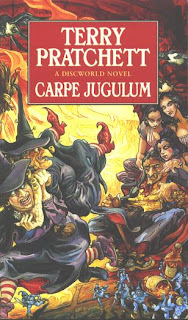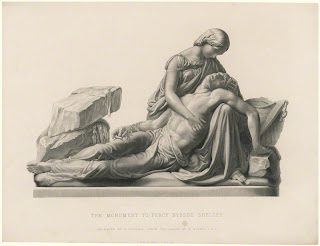So, we’ve looked at vampires and
Frankenstein’s Monster and, as they say (although just who they are
remains an open question), these things come in threes, so to complete this
inhuman trio, the subject for today is the werewolf. ‘Werewolf’ has two elements
– were and wolf; the final bit is easy enough, as it’s a word we
still use today for the animal today, although in the past it could be used to
describe any animal, (as could the word hund or hound).
 |
| Werewolf |
Were
means an adult male human and is still used in some dialects (it’s a word I
have used when speaking Lancashire dialect, although it is rare), and is
related to the Latin word for a man – vir, as in virile or virility, the
Welsh - gŵr and the Gaelic - fear meaning ‘a man’. It occurs in weregeld
– ‘man-price’ – the compensation paid to a family or clan if a member was
killed, (the Danegeld – ‘Dane-price’ – was paid to the Vikings to
prevent them from ravaging England). Some say that the werewolf was a
warrior who wore a wolf-skin into battle, just as the berserkers wore
bear-skins, (serkr is Old Norse for shirt or coat, cognate with the
Scots sark – as in Cutty Sark – ‘a short shirt’.) but I find this
a little fanciful (they would be Úlfhéðnar, surely). Others have thought
the werewolf derives from wargwolf, as a warg was a rogue wolf,
often running alone, which slaughtered flocks of domestic animals, but this
strikes me as a tautology (although a ‘wolfs-head’ was once the term for
an outlaw who could be killed without impunity and who it was forbidden to aid).
More usually, the werewolf is a man who transforms into a wolf, usually when
the moon is full.
 |
| 18th Century Werewolf |
In Classical mythology, there are
numerous references to men who turn into wolves. In Book IV of his Histories,
Herodotus writes about the Neuri, a tribe of men who transform into wolves once
every year. Ovid, in the Metamorphoses, writes of “That wolf who
counterfeits a human shape” (Book VII). The legend of Lycaon tells how this
King of Arcadia murders Nyctimus, one of his fifty sons, and serves the
body to Zeus at a feast, in an attempt to test Zeus’s omniscience. In a fury,
Zeus kills the rest of Lycaon’s sons with thunderbolts, restores Nyctimus to
life, and transforms Lycaon into a wolf.
Pausanius, in his Description of
Greece, (Book VIII), gives a variation, in that Lycaon sacrifices a child
to Lycaean Zeus and sprinkles the blood on the altar, whereupon he is changed
into a wolf. Thereafter, a man at the sacrifice to Lycaean Zeus will always be
transformed into a wolf, for nine years if he does not eat human flesh and
forever if he does. The Greek word for wolf is λύκος (lýkos) and ‘human’
is άνθρωπος (ánthrōpos) – giving us another term for the werewolves – lycanthropes
(wolf-men).
 |
| Zeus and Lycaon |
The legend of the werewolf is
found across continental Europe although it not common in England, maybe
because wolves were eradicated during Anglo-Saxon times (the last English wolf
was killed at Humphrey Head, Lancashire in about 1390), although there are many
tales of ghostly or devil dogs. In countries where wolves are scarce or absent,
there are tales of were-lions, were-tigers, were-bears, were-hyenas and so on,
which indicates that the concept of men transforming into predatory animals is
universal. The literature of the werewolf in the nineteenth century was largely
a retelling of various medieval romances and legends and there are no real
notable works; Alexandre Dumas, author of The Three Musketeers and The
Count of Monte Christo, wrote The Wolf Leader in 1857, a short
novella that has been described as “Dumas's drabbest hack-work.”
 |
| Illustration from A Dumas - The Wolf Leader - 1904 trans. |
The
best non-fiction work from the period is Sabine Baring-Gould’s The Book of
Werewolves (1865), which brings together and examines the werewolf
phenomena from myths and legends, together with cases of ‘real’ werewolves from
medieval history, and remains one of the best source books on the subject. In
Bram Stoker’s Dracula (1897), the hero Jonathan Harker travels to the
Carpathians, where he hears people speaking of
“… vrolokj and vlkoslak both of which mean the same thing, one being Slovak and the other Servian for something that is either were-wolf or vampire.”
As with Dracula and
Frankenstein’s Monster, the Wolfman featured in early films; the first, from
1913, The Werewolf is now lost, as is the German Werewolf (1932).
Wolfblood (1925) is an oddity, a silent film set in a Canadian logging
camp, where Dick Bannister, a new manager, is attacked by thugs from a rival
logging concern and left for dead. He urgently needs a blood transfusion but
the lumberjacks refuse to help, so the doctor uses the blood of a wolf instead
(!) and Bannister begins to dream of running with wolves. The rival loggers
begin to be killed by wolves and the rumour that Bannister is a werewolf begins
to circulate. Edith, owner of the camp, had been engaged to the doctor but she
had broken it off when she fell for Bannister, and the doctor tells her that
Bannister will become more and more like a wolf, in a vain bid to win her back.
Eventually, the doctor confesses that the wolf blood will do no harm to
Bannister, who rides off into the distance with Edith.
 |
| Henry Hull - Werewolf of London - 1935 |
In 1935, Werewolf of
London featured the first bipedal, anthropomorphic wolfman, with make-up by
Jack Pierce (who created Karloff’s Frankenstein), but failed at the box office,
where it was seen as too similar to Dr Jekyll and Mr Hyde released three
years earlier.
 |
| Lon Chaney Jr as the Wolfman |
In 1941, Lon Chaney Jr starred in The Wolf Man, a film
which set the standard for all future werewolf films and is referenced by many
of them, not least in the verse: -
‘Even a man who is pure in heartAnd says his prayers by nightMay become a wolfWhen the wolfbane bloomsAnd the autumn moon is bright.’
Larry Talbot, the main character,
is transformed into a wolfman after being bitten in the chest by a werewolf and
goes on a killing spree in the local village. Eventually, his father beats him
to death with his own a silver-headed cane. Chaney, playing Talbot, reprieved
the role in a number of sequels over the years.
 |
| Jack Pierce making-up Lon Chaney Jr |
The cinematic wolfmen fall into
two broad categories, the vicious, mindless killers or the tragic, haunted victims,
and many of the ‘traditions’ of the werewolf come from the films - the
‘infection’ by the bite of a werewolf, the transformation at the full moon, the
immunity to all weapons bar the silver bullet, the increased speed and
strength, the interaction with real wolves and so on and so forth. The werewolf
continues to appear in modern films (I won’t list them… ) and in television
programmes (… but I will mention the BBC’s superb Being Human), as well
as in books and graphic novels.
 |
| An American Werewolf in London - 1981 |
And, of course, I cannot end
without mentioning the song with what was voted by BBC Radio 2 listeners as the
best opening lines of a pop song ever – Warren Zevon’s Werewolves of London.
I saw a werewolf with a Chinese menu in his hand
Walking through the streets of Soho in the rain
He was looking for the place called Lee Ho Fook's
Gonna get a big dish of Beef Chow Mein.









































